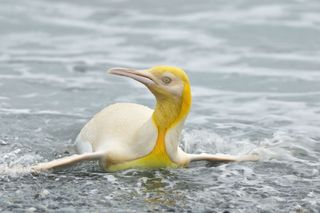During a 2019 expedition to the South Atlantic, Belgian photographer, Yves Adams, anticipated encountering the usual king penguins, recognizable by their distinct black and yellow plumage on their heads and necks, with a streak of orange along their beaks. However, what Adams encountered was nothing short of remarkable: a strikingly vivid yellow penguin.

At Salisbury Plains, a renowned stretch of shoreline on South Georgia Island, up to 120,000 king penguins can be seen congregating, creating a vast stretch of black plumage- but the animal Adams saw stood out from the rest: A bird with an ivory-white bill, a cream-colored body, and a mane of lemon-hued feathers.
King penguins (Aptenodytes patagonicus), much like their close relatives, the emperor penguins (Aptenodytes forsteri), usually sport a black-and-white ensemble with a touch of yellowish-gold around their collar, however, this specific penguin appears to have maintained its yellow feathers while shedding its dark ones, typically pigmented by melanin, resulting in a distinctive appearance.
According to the Australian Antarctic Program, penguins exhibiting uncommon plumage are relatively uncommon, and determining the cause behind these rare colors solely by visual observation can be rather difficult. Some unusual coloring can be due to injury, diet or disease, but many cases are attributed to genetic mutations within the birds. These mutations can result in phenomena such as "melanistic" penguins, where typically white areas appear black, or "albinistic" penguins lacking melanin entirely, resulting in white plumage.
Unusually colored birds like these are uncommon, and there's likely a good reason for it.
When penguins have an excess of pigment in their feathers, a condition known as melanism, it results in an overall darker coloration. These darker individuals might stand out more in the water compared to their counterparts and may find it challenging to approach fish stealthily.
On the other hand, paler penguins are at a higher risk of predation by leopard seals or killer whales in the Antarctic.
Adams told Kennedy News that the yellow bird exhibits leucism, a genetic condition causing partial loss of melanin. Dee Boersma, a conservation biologist and professor at the University of Washington, agreed- however noted that while the penguin lacks some pigment, it retains brown pigment on its head, suggesting it's not a true albino.
Others disagree.
Kevin McGraw, an integrative behavioral ecologist at Arizona State University, disagrees, suggesting the bird appears albino due to the absence of melanin in its plumage, feet, and eyes. Thomas agrees with other experts that "feather samples for biochemical testing would be needed to document if melanin is present."
As an environmental science student, I find this article fascinating. The discovery of a vivid yellow penguin exhibiting leucism must have been incredibly exciting for the researchers and photographers in the field. It's interesting to see how these photos offer a glimpse into the relationship between genetics and animal phenotypes. As I finish up my undergraduate experience, I believe it is safe to say understanding how genetic mutations manifest in wildlife populations is crucial for conservation efforts and sheds light on the complexities of natural selection- it is also always nice to see some beautiful photos of wildlife.
No comments:
Post a Comment